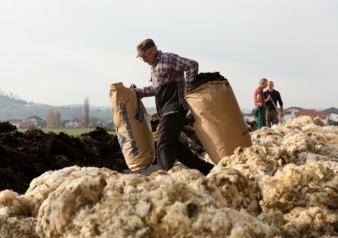26/08/2025 – Crisis and future of Swiss sheep’s wool
Swiss wool between potential and pressure
The purchase of Swiss wool was suspended in spring 2025 – a consequence of shrinking demand and a lack of infrastructure. What happens when a natural material with unique properties can no longer find a market?
The Swiss wool industry is under pressure: full warehouses, declining processing capacity, and, above all, a drop in demand have prompted Swisswool to suspend the 2025 spring collection. This was a temporary measure that applies only to the spring season – a normal autumn collection is anticipated. Despite the challenges, Swisswool remains a major buyer and processor of Swiss wool and is investing strategically in new markets and product development.
Structural change and declining demand
Demand for Swiss wool has dropped – particularly in highvolume segments such as the mattress and insulation industries. Here, synthetic materials are increasingly replacing functional natural fibres like wool, even though wool clearly outperforms in areas such as thermal regulation, moisture management, flame resistance and sustainability. The situation is exacerbated by the financial difficulties of Swisswool’s long-standing partner scouring plant in Belgium. With only a few industrial-scale wool scouring facilities left in Europe, this structural gap affects the entire supply chain.
textile network spoke with Friedrich Baur, Managing Director of Swisswool, about the challenges and opportunities facing the Swiss wool industry. Baur explains why full wool processing in Switzerland is becoming increasingly difficult, how the situation looks across Europe, and what steps are necessary to restore value to this natural fibre and boost its demand.
textile network: What role does wool play in Swiss agriculture?
Friedrich Baur: Wool may not be the most profitable product in sheep farming, but it is essential for full-cycle utilisation. Only when sheep provide meat, milk and wool does it make environmental and economic sense – particularly in alpine regions. If wool can no longer be marketed, the entire system is under pressure.
textile network: Why is full wool processing in Switzerland so difficult?
Friedrich Baur: Industrial infrastructure for washing, sorting and processing wool has largely disappeared in Switzerland. Swisswool helps maintain wool utilisation through cross-border partnerships – a pioneering effort that supports the entire value chain.
textile network: Is the situation similar in other European countries?
Friedrich Baur: Yes. Across Europe, only about a third of shorn wool is actually used. Infrastructure and knowhow have been lost in many places – posing risks to economic, ecological and cultural systems.
textile network: What happens to wool that cannot be used for textiles?
Friedrich Baur: Not all wool is suitable for clothing or fine textiles. Coarse or coloured fibres are processed into acoustic elements, insulation, carpets or even fertilisers.
textile network: What needs to happen for more Swiss wool to be used?
Friedrich Baur: Wool needs to be revalued – not as waste, but as a climate-positive material. That requires education, design and trustworthy communication. As more people understand the value of natural fibres, demand will follow. Without greater visibility, Swiss wool remains underused.
textile network: Thank you for the insight into the Swiss wool market!





